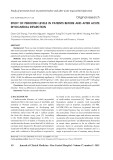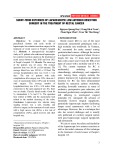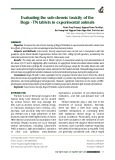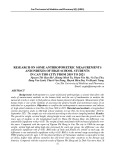
Can Tho Journal of Medicine and Pharmacy 9(6) (2023)
1
CHARACTERISTICS OF LDL-C ELEVATION AND
THE TREATMENT OUTCOMES OF ROSUVASTATIN
IN PATIENTS WITH ACUTE MYOCARDIAL INFARCTION
AT TRA VINH GENERAL HOSPITAL 2021-2022
Nguyen Trung Kien1, Nguyen Minh Hoang2, Pham Thi Ngoc Nga1,
Tran Tin Nghia1, Dang Quang Phu1, Ha Thi Thao Mai1*
1.Can Tho University of Medicine and Pharmacy
2. Tra Vinh General Hospital
*Corresponding author: httmai@ctump.edu.vn
Received: 11/01/2023
Reviewed:07/9/2023
Accepted: 03/10/2023
ABSTRACT
Background: Myocardial infarction (MI), sometimes referred to as a heart attack, is a leading
cause of mortality on a global scale. This medical ailment is sometimes referred to as a myocardial
infarction. To mitigate the issue, it is essential to promptly conduct diagnostic examinations and start
therapy for lipid abnormalities. Objectives: The aim of this study is to provide a comprehensive
description of the variables associated with elevated low-density lipoprotein cholesterol (LDL-c) levels
and to evaluate the treatment results of rosuvastatin in patients diagnosed with acute myocardial
infarction at Tra Vinh General Hospital throughout the period of 2021-2022. Materials and methods:
The objective of each of these experiments was to ascertain the attributes associated with high low-
density lipoprotein cholesterol (LDL-c). Both of these trials were designed to be carried out on
individuals who had a previous record of increased levels of low-density lipoprotein cholesterol (LDL-
c). Enumerated here are the many procedures and components: A total of 199 individuals were included
in a cross-sectional research, all of whom presented with both early-onset acute myocardial infarction
and dyslipidemia. The aforementioned people originated from four separate familial lineages
characterized by a historical prevalence of the aforementioned ailment. The research described in this
study was conducted inside the Department of Cardiology-Geriatrics, with no intervention being
necessary. Results: The findings indicate that 52.5% of those who had LDL-c level assessments
demonstrated ideal levels, while 24.2% exhibited levels that were somewhat near to the normal range.
Additionally, 3.0% of the participants displayed LDL-c levels that significantly above the normal range.
Following the conclusion of the therapeutic intervention, the LDL-c concentrations of the participants
exhibited a notable reduction, with an average value of 1.10±0.61mmol/L. Furthermore, a significant
proportion of the participants, namely 63.8%, achieved the predetermined control objective.
Conclusions: The administration of the rosuvastatin regimen has been shown to be a highly successful
approach in attaining the necessary elevation of LDL-c levels, hence playing a crucial role in the
management and prevention of many medical conditions among patients and their families.
Keywords: myocardial infarction (MI), rosuvastatin, patient family pedigrees.
I. INTRODUCTION
Today, myocardial infarction (MI) remains one of the major causes of death and
disability worldwide. In 2020, it is estimated that about every 40 seconds, an American will
have an acute MI and the disease is becoming more common [1]. Causes of acute MI that
appear early include lifestyle, smoking, and atherosclerosis, which are one of important
causes. The main cause in about 85% of cases of familial hypercholesterolemia is a mutation
in the gene encoding the low-density lipoprotein receptor, which causes elevated levels of







![Study on toxicities of 10β-[(2'β-hydroxy-3'- imidazol) propyl] deoxo-artemisinin (32) in reproductive and developmental progresses of mice](https://cdn.tailieu.vn/images/document/thumbnail/2025/20250228/viinuzuka/135x160/8021740737116.jpg)
































